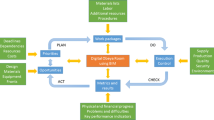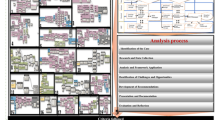Abstract
Virtual design and construction are essential services in the construction industry. The construction companies need to be prepared to meet the increasing demands. Building information modeling (BIM) has many advantages compared to the traditional method of drawing. Further, improving the BIM process will enhance the efficiency of the construction process. The lean concept aims to reduce or eliminate waste and improve the process. This study aims to improve the BIM process by applying lean tools. Value stream map (VSM) is used to visualize the workflow and evaluate the current practice of BIM, including architectural and structural modeling of high-rise buildings. Autodesk Revit 2016 and Navisworks Manage 2021 are used for the present study. Automation for the BIM process is created using Dynamo script to improve the BIM process. The efficiency of the existing workflow is calculated and compared with the new workflow. The Dynamo script created for extracting material schedule shows an increase in the process cycle efficiency by saving a significant amount of time, especially at an organizational level. BIM modelers will be benefited from the automation proposed in the study.












Similar content being viewed by others
Data availability
Not applicable.
Code availability
Not applicable.
References
Abhishek, P. G., & Pratap, M. (2020). Achieving lean warehousing through value stream mapping. South Asian Journal of Business and Management Cases., 9(3), 387–401.
Ahuja, R. S. (2014). BIM based conceptual framework for lean and green integration. In Proceedings of the 22nd Conference of the International Group of Lean Construction, 25–27.
Al Hattab, M. (2015). Using social network theory and simulation to compare traditional versus BIM–lean practice for design error management. Automation in Construction, 52, 59–69.
Brown, M. (2022). Industry rates for BIM services & building information modeling costs. Retrieved from cad crowd: https://www.cadcrowd.com/blog/building-information-modeling-services-and-cost/
Dantas Filho, J., Angelim, B. M., & Barros Neto, J. (2016). Virtual design and construction leaner than before. In: Proceedings of the 24th Annual. Conference of the International. Group for Lean Construction, (pp. 83–92). Boston, MA, USA.
Dantas, B. (n.d.). Implementing Lean to Improve BIM Processes. Retrieved from Lean Construction Blog: https://leanconstructionblog.com/Implementing-Lean-to-improve-BIM-processes.html
Dinesh, R., Sathish Kumar, V. R., & Krishnakumar, M. (2019). Capacity enhancement through value stream mapping and line balancing technique in compressor assembly line. International Journal of Innovative Technology and Exploring Engineering (IJITEE), 8(10).
Ganiyu, S. A. (2020). BIM competencies for delivering waste-efficient building projects in a circular economy. Developments in the Built Environment, 4, 100036.
Langstrand, J. (2016). An introduction to value stream mapping and analysis. Available at: http://liu.diva-portal.org/smash/get/diva2:945581/FULLTEXT01.pdf (Accessed 3 Jul 2022).
Lean Tools and Principles and Their Applications. (n.d.). Retrieved from Purdue University: https://www.purdue.edu/leansixsigmaonline/blog/lean-tools
Mukherjee, J. V. (2009). Scope of building information modeling (BIM) in India. Journal of Engineering Science and Technology Review, 165–169.
Nikhil Nandakumar, P. G., & Saleeshya, P. H. (2019). Bottleneck identification and process improvement by lean six sigma DMAIC methodology. Materials Today: Proceedings, 24(2020), 1217–1224.
Ramalingam, S. (2018). Mapping of BIM process for teaching lean. Proceedings 26th Annual Conference of the International. Group for Lean Construction (IGLC), González, V.A. (ed.), 1291–1301.
Sacks, R. K. (2010). Interaction of lean and building information modeling in construction. Journal of Construction Engineering and Management, 136(9), 968–980.
Sample Value Stream Mapping Template for Presentation. (n.d.). Retrieved from slideegg: https://www.slideegg.com/value-stream-mapping-template
Shi, A. (2020). 5D BIM applications in quantity surveying: dynamo and 3D printing technologies. Smart Cities and Construction Technologies.
Swapnesh, P. R., & Valunjkar, S. S. (2017) Improve the productivity of building construction project using clash detection application in building information modelling. International Research Journal of Engineering and Technology (IRJET), 4(3) e-ISSN: 2395-0056.
Venugopal, V., & Saleeshya, P. G. (2019). Manufacturing system sustainability through lean and agile initiatives. International Journal of Sustainable Engineering, 12(3), 159–173.
Funding
This research did not receive any funding.
Author information
Authors and Affiliations
Contributions
All authors contributed to the study conception and design. Material preparation, data collection and VSM analysis were performed by Anupama and Anand. Implementation of Dynamo script was performed by Anupama and Harikrishnan. The first draft of the manuscript was written by Anupama and all authors commented on previous versions of the manuscript. All authors read and approved the final manuscript.
Corresponding author
Ethics declarations
Conflicts of interest
On behalf of all authors, the corresponding author states that there is no conflict of interest.
Human participants or animals
This article does not contain any studies involving human participants or animals performed by any of the authors.
Additional information
Publisher's Note
Springer Nature remains neutral with regard to jurisdictional claims in published maps and institutional affiliations.
Rights and permissions
Springer Nature or its licensor (e.g. a society or other partner) holds exclusive rights to this article under a publishing agreement with the author(s) or other rightsholder(s); author self-archiving of the accepted manuscript version of this article is solely governed by the terms of such publishing agreement and applicable law.
About this article
Cite this article
Anupama, V.M., Anand, K.B., Ramkrishnan, R. et al. Application of lean principles for efficiency enhancement of BIM process. Asian J Civ Eng 24, 2727–2737 (2023). https://doi.org/10.1007/s42107-023-00628-y
Received:
Accepted:
Published:
Issue Date:
DOI: https://doi.org/10.1007/s42107-023-00628-y




